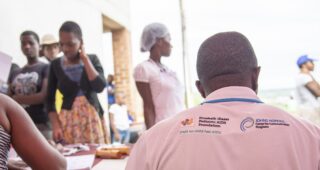Innovative Pediatric HIV Treatment Formulation Represents Significant Progress
You are here

Children living with HIV face many challenges when it comes to treatment, one being that often pediatric HIV medications are difficult for infants and young children to take due to their taste, making adherence difficult for parents and caregivers. Recent tentative approval by the U.S. Food and Drug Administration of a new pediatric ARV formulation of oral pellets of lopinavir and ritonavir (LPV/r) that can be mixed into a child’s food represents significant step in addressing this obstacle. Manufactured by Indian generic medicines manufacturer CIPLA, the new formulation is a viable alternative to the currently used liquid formulation of LPV/r that contains high proportions of alcohol and potentially toxic propylene glycol.
Regions most affected by incidence of pediatric HIV, such as sub-Saharan Africa will benefit the most, as the new formulaiton is heat-stable and more palatable for children. As a next step, with the support of UNITAID and Drugs for Neglected Diseases initiative (DNDi), CIPLA now aims to develop two "4-in-1" fixed-dose combinations of LPV/r with other key ARV drugs that are recommended for the first-line antiretroviral treatment (ART) in children younger than 3 years of age by the World Health Organization (WHO). Moreover, the intellectual property issues around access to future LPV/r combinations will be reduced following a recent licensing agreement the Medicine Patent Pool (MPP) signed in in December 2014 with AbbVie, the patent holder for LPV/r. Strong support prompting this positive development was provided by the Pediatric HIV Treatment Initiative created in 2014 by UNITAID, Clinton Health Access Initiative (CHAI), DNDi and the MPP to accelerate the development of priority pediatric ARVs within the next three years, through working with drug manufacturers to develop and supply ARVs, and to increase prompt access by facilitated regulatory approval, adoption, and rapid uptake of novel pediatric ARV drug formulations in high-burden countries.
Even with the successful roll out of Option B+ the transmission of HIV from mother to child is still far from being fully eliminated. Every day almost 700 children become newly infected with HIV. Half of these children will die by the age of 2, and 80 percent will die before their fifth birthday without diagnosis and treatment. The approval of the new LPV/r pellets formulation will not only facilitate early initiation of ART among infants and young children living with HIV, it will also allow for the significantly more robust uptake of the 2013 WHO pediatric treatment guidelines which recommend immediate initiation of ART for all HIV-positive children younger than 5 years immediately following their diagnosis. It also aligns with key goals outlined by the U.S. President’s Emergency Plan for AIDS Relief (PEPFAR) to improve pediatric HIV treatment, including the Accelerating Children's HIV/AIDS Treatment Initiative and the Global Pediatric ARV Commitment to Action.
These new oral pellets will help bring us closer to closing the treatment gap for the 3.2 million children living with HIV around the world. Early introduction of ART saves lives, and allows children to develop to their full potential in life.
Natella Rakhmanina, M.D. Director of Technical Leadership
General



